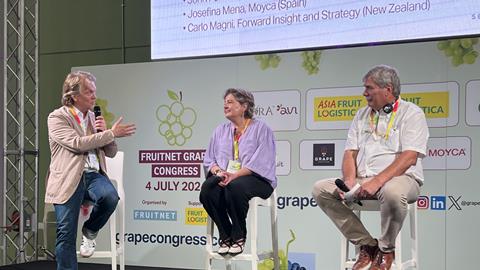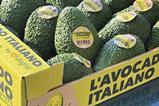Leading analysts and key industry players at global event in Puglia say they see huge market potential thanks to new and better varieties
Grape suppliers must continue to invest in better-tasting and more climate-resilient varieties if they are to retain their share of the market. But they also need to avoid presenting consumers with too many different types of grape if they are to improve sales.
Those were among the key messages delivered to around 250 delegates from 16 different countries who attended the Fruitnet Grape Congress in Puglia, Italy, on 4 July.
“Consumers do really like grapes, and in the last four turbulent years we have seen that demand especially in Europe is robust,” said leading analyst Cindy van Rijswick of Rabobank Research Food & Agribusiness during her opening keynote presentation.
“But the industry must not fall asleep. It needs to pay attention to the fact that costs and risks for growers are a lot higher now.”
Market prices over the past year or so have been reasonably good, Van Rijswick noted, but she also indicated that much of the recent consumer price inflation had been accompanied by significantly higher costs and supply chain risks.
Nevertheless, she said, the introduction of some really innovative, great-tasting grapes with improved shelf-life had kept consumers and trade buyers keen.
“New varieties have really tapped into opportunities with consumers,” she explained. “But the industry needs more new varieties that can cope with drought and other weather extremes resulting from climate change. The products need to be a win-win for the whole supply chain to be successful.”
More consistency
For Josefina Mena, commercial manager of Spanish company Moyca, the challenge today is indeed to identify which of those varieties will tick all of the boxes when it comes to consumer demands, retail requirements, and grower returns.
“We were previously working with more than 50 varieties, but now we are trying to reduce that and work out which are the best,” she revealed. “In the beginning, it wasn’t easy to introduce new varieties and flavours because they didn’t want to pay the extra money that they cost. But the northern European markets helped us. And now breeders are giving us more consistency, better crunch, better shelf-life.”
Over the past few decades, the major market trend as new suppliers in Spain and Latin America entered the grape business has been the replacement of seeded with seedless varieties.
For John Pandol of California-based Pandol Bros, the recent varietal proliferation has been very positive because it has enabled certain suppliers to deliver a much better eating experience, better sales for vendors, and more sustainable business for the growers and exporters themselves.
“We’ve never had more varieties and sources, and we’ve never had more disruption,” he told delegates. “It’s a very good and sound thing to have more sources and more product available. In California, Thompson and Red Globe used to 70 per cent of our production. Today, our biggest varieties are probably only 40 per cent.”
Both Pandol and Mena agreed that the grape supply base was undergoing a period of consolidation. “There are so many more varieties,” said Pandol. “And look at the pile of failed ones. It’s about trial and failure.”
So could the sector see the overall number of grape varieties level out, or even fall? Pandol suggested each supplier and each production region would eventually reach an optimum number of varieties.
“In our case, with a five month season, we have three to four red and white, maybe three blacks, and then maybe a speciality. For us, the ideal number is maybe up to 18.”












